Fig. 6
|
foxc1b Required Downstream Cilia and Notch Signaling to Recruit vMCs around Developing Vasculature (A) Shear stress modulates expression of FOXC1 and FOXC2. Arterial endothelial cells exposed to 24 hr of LSS show increased expression of FOXC1, FOXC2, and SOX17 genes. Data are represented as mean ± SD. Stars represent the results of one-way ANOVA. ∗∗∗∗p < 0.00011. (B) Blockade of shear stress in zebrafish inhibits foxc1a and foxc1b gene expression. qPCR analysis of foxc1a and foxc1b gene expression in zebrafish injected with control MO, gata1 MO, and tnnt2 MO. Foxc1b is more affected by the lack of flow compared to foxc1a. Data are represented as mean ± SD. Stars represent the results of two-way ANOVA. ∗∗p < 0.01. (C) Primary cilia impairment inhibits zebrafish foxc1a and foxc1b gene expression. qPCR analysis of foxc1a and foxc1b gene expression in zebrafish control and 1 or 2 μM CBD-treated embryos at 48 hpf. The trunk of treated embryos was used for RNA extraction and qPCR analyses. Foxc1b is more affected by the lack of cilia compared to foxc1a. Data are represented as mean ± SD. Stars represent the results of two-way ANOVA. ∗p < 0.1. (D) Endothelial-cell-specific foxc1a inhibition reduces vMC recruitment around the DA. Confocal images of partial z-projections of the trunk region (somite 8–14) of Tg(kdrl:egfp)s843;Tg(acta2:mCherry)uto5 embryos at 80 hpf (merged and single channels) injected with endothelial-cell-specific foxc1a cKO plasmid together with Tol2 mRNA. Cmlc2-negative embryos were used a control (ctrl). Asterisks indicate acta2-positive somites in cmlc2:GFP-positive embryos. n = 10 and 10 embryos. Right: scatter plots show the number of vMCs counted along 500 μm of the DA. ns indicates no significant difference in a one-way ANOVA test. Data are represented as mean ± SD. (E) Endothelial-cell-specific foxc1b inhibition reduces vMC recruitment around the DA. Confocal images of partial z-projections of the trunk region (somite 8–14) of Tg(kdrl:egfp)s843Tg(acta2:mCherry)uto5 embryos at 80 hpf (merged and single channels) injected with endothelial-cell-specific foxc1b cKO plasmid together with Tol2 mRNA. Cmlc2:GFP-negative embryos were used as control (ctrl); n = 20 and 20 embryos. Right: scatter plots show the number of vMCs counted along 500 μm of the DA. Data are represented as mean ± SD. Stars represent the results of two-way ANOVA. ∗∗∗p < 0.001. (F) Foxc1b, but not foxc1a or sox17, expression restores vMC recruitment in absence erythrocytes and reduced shear stress in zebrafish vessels. Scatter plots show the quantification of vMC number per 500 μm of the DA obtained from confocal images of partial z-projections of the trunk region (somite 8–14) of Tg(kdrl:egfp)s843Tg(acta2:mCherry)uto5 embryos at 80 hpf after gata1 morpholino injection alone or with mRNA of foxc1b, foxc1a, or sox17, respectively. Compared to gata1 morphants, coinjection of foxc1b showed restored vMC recruitment around the DA. n = 34, 35, 34, 15, and 19 embryos, respectively. Data are represented as mean ± SD. Stars represent the results of one-way ANOVA-Dunnett’s post hoc test. ∗p < 0.05, ∗∗p < 0.01, ∗∗∗p < 0.001, ∗∗∗∗p < 0.0001. (G) vMC recruitment is rescued by expression of foxc1b in a zebrafish embryo chemically inhibited for cilia formation. Scatter plots show the quantification of vMC number per 500 μm of the DA obtained from confocal images of partial z-projections of the trunk region (somite 8–14) of Tg(kdrl:egfp)s843Tg(acta2:mCherry)uto5 embryos at 80 hpf. After injection of the mRNA of foxc1b, foxc1a, or sox17 at one single-cell stage, embryos were again injected in the pericardium with CBD or DMSO at 54 hpf. Only embryos carrying exogenous foxc1b expression showed restored vMC recruitment around the DA after cilia impairment. n = 40, 52, 21, 41, 9, and 10 embryos, respectively. Data are represented as mean ± SD. Stars represent the results of one-way ANOVA-Dunnett’s post hoc test (∗p < 0.05, ∗∗p < 0.01, ∗∗∗p < 0.001, ∗∗∗∗p < 0.0001). (H) foxc1b expression is downstream of Notch signaling. Representative images of whole-mount in situ hybridization of foxc1b gene in zebrafish Tg(dll4:Gal4;UAS:mCherry;UAS:NICD) embryos at 48 hpf injected with control or gata1 morpholino. Arrows show specific foxc1b expression. Ten embryos for each condition were analyzed, and all of them showed the specific phenotype. (I) Arterial Notch activation (NICD) rescues flow-dependent impairment of foxc1b expression. qPCR analysis of foxc1b gene expression in zebrafish Tg(dll4:Gal4;UAS:mCherry;UAS:NICD) embryos at 48 hpf injected with control or gata1 morpholino. Reduced foxc1b expression in gata1 morphants is fully rescued by arterial NICD expression. Data are represented as mean ± SD. Stars represent the results of one-way ANOVA-Dunnett’s post hoc test (∗∗p < 0.01). See also Figures S11–S13.. |
| Genes: | |
|---|---|
| Fish: | |
| Condition: | |
| Knockdown Reagents: | |
| Anatomical Terms: | |
| Stage Range: | Long-pec to Protruding-mouth |
| Fish: | |
|---|---|
| Condition: | |
| Knockdown Reagents: | |
| Observed In: | |
| Stage Range: | Long-pec to Protruding-mouth |

